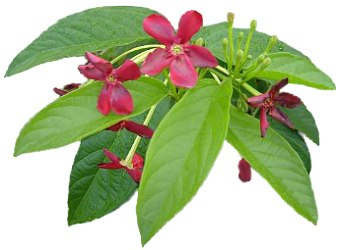 |
||
|
Home 10 DOH Herbs Adelfa Akapulko Ampalaya Balanoi Banaba Bayabas Bawang-Garlic Carrot | Karot Luyang Dilaw Gumamela Lagundi Mabolo Malunggay Makabuhay Niyog-Niyogan Oregano Pandan Pansit-Pansitan Sabila Saluyot | Jute Sambong Silymarin Tanglad-Lemon Grass Tsaang Gubat Virgin Coconut Oil Yerba Buena |
Niyog-Niyogan (Quisqualis Indica L.) |
|
 Niyog-niyogan or Rangoon Creeper is an excellent
vine for outdoor gardens. This ligneous plant, scientifically called
Quisqualis indica L. It is also known as Burma or Rangoon
Creeper, Liane Vermifuge and Chinese honeysuckle. Niyog-niyogan is
perfect for covered walkways as it grows at least 2.5m long and reaches
up to 8m long when it matures. This active climber, which belongs to
the combretaceae family grows best in tropical areas and demands
constant sunlight. Perhaps due to its tropical characterization that
it is found in primary and secondary forests of countries like Africa,
China, Taiwan, Malaysia, Philippines, Vietnam, Papua New Guinea and
other Asian regions. Niyog-niyogan or Rangoon Creeper is an excellent
vine for outdoor gardens. This ligneous plant, scientifically called
Quisqualis indica L. It is also known as Burma or Rangoon
Creeper, Liane Vermifuge and Chinese honeysuckle. Niyog-niyogan is
perfect for covered walkways as it grows at least 2.5m long and reaches
up to 8m long when it matures. This active climber, which belongs to
the combretaceae family grows best in tropical areas and demands
constant sunlight. Perhaps due to its tropical characterization that
it is found in primary and secondary forests of countries like Africa,
China, Taiwan, Malaysia, Philippines, Vietnam, Papua New Guinea and
other Asian regions.Niyog-niyogan is cultivated in greenhouses and can be naturalized in tropical areas. This vine starts as a shrub about 3-feet tall with branches growing from all directions. The mother shrub seizes to grow and dies after six months allowing the creeper to rapidly climb walls, trees, and the like. The branches of niyog-niyogan are filled with oblong-shaped leaves growing on opposite sides attached to 6mm to 10mm long petioles. The leaves of niyog-niyogan can grow up to 15cm long and more than 5cm wide with a pointed tip. Its flowers grow in clusters and it blossoms year-round. Its flowers open at night with five bright red petals and gives out a distinct perfume. The young flowers of niyog-niyogan start with white-colored petals that turn pink then red as it matures. It also bears fruits, which can grow up to 3cm long with five angles on its sides. The niyog-niyogan plant grows in haste during the rainy season, hence constant pruning is especially recommended during this time. It is advised to place this plant in spacious areas to avoid crowding with a temperature of at least 60°F with evenly moistened soil to produce flowers. Niyog-niyogan can thrive in almost all kinds of soil and can even tolerate moderate amount of drought in cold seasons. |
||
|
Benefits & Treatment of Niyog-Niyogan:
Almost all of its parts are used individually, or mixed with other ingredients, as remedy to different ailments. In the Philippines, these are taken to rid people of parasitic worms. Some also use these to help alleviate coughs and diarrhea. Medical experts, advice patients to consult their doctors as improper dosing may cause hiccups. Niyog-niyogan’s leaves are used to cure body pains by placing them on specific problematic areas of the body. Compound decoctions of the leaves of niyog-niyogan are used in India to alleviate flatulence. |
Preparation & Use:
Seeds of niyog-niyogan can be taken as an anthelmintic. These are eaten raw two hours before the patient’s last meal of the day. Adults may take 10 seeds while children 4 to 7 years of age may eat up to four seeds only. Children from ages 8 to 9 may take six seeds and seven seeds may be eaten by children 10 to 12 years old.
Decoctions of its roots are also sometimes used as a remedy for rheumatism while its fruits are used as an effective way to relieve toothaches. |
|
|
| ||
Other Herbal & Non-Herbal Medicine: Philippine Plants, Fruits & TreesAbaca Plant | Avocado | Atis Fruit | Banana Plant | Barako Coffee | Coconut Palm Tree | Durian Fruit | Guyabano Fruit | Mango Tree | Mangosteen | Papaya Fruit | Pineapple Nutrition Fact | Rubber Tree | Tomato Nutrition Facts | Tuba-Tuba Plant - Jatropha Key to Nutritional Healing | Philippine Medicinal Plants List |
||
| Philippine Herbal Medicine © 2005-2024
|
||